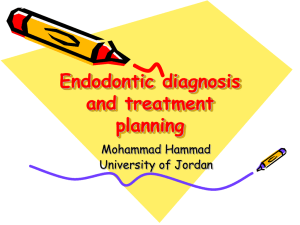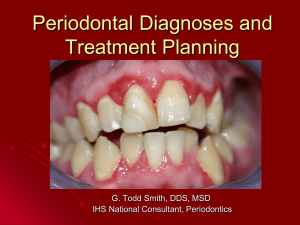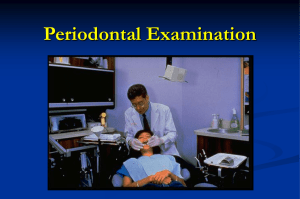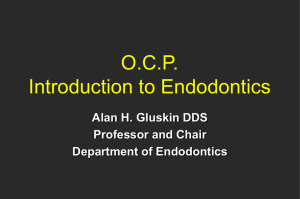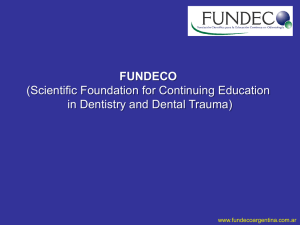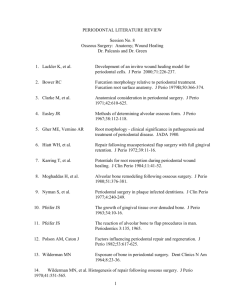Endodontic Periodontal Lesions
advertisement
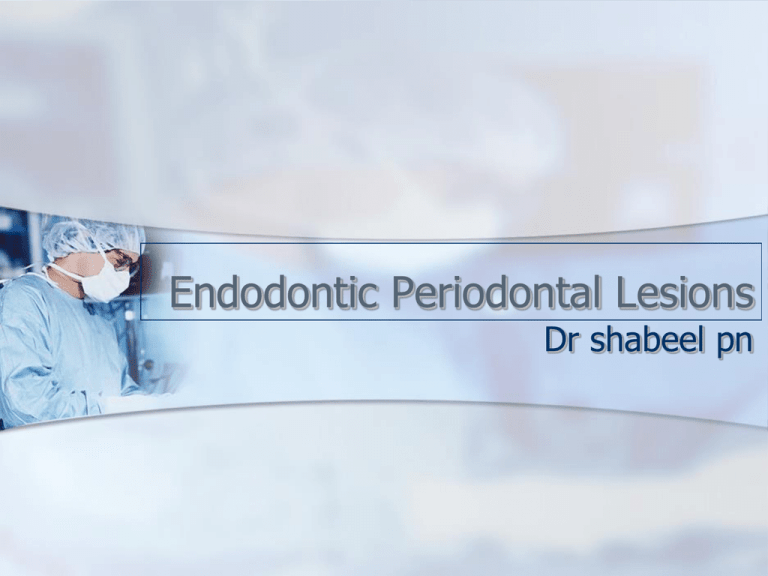
Endodontic Periodontal Lesions Dr shabeel pn Anatomic Considerations There is an intimate relationship between the periodontium and pulpal tissues As the tooth develops and the root is formed, 3 main avenues for communication are created: 1. 2. 3. Apical Foramen Lateral and Accessory Canals Dentinal Tubules Apical Foramen It is the principal and the most direct route of communication between the pulp and periodontium Bacterial and inflammatory byproducts may exit readily through the apical foramen to cause periapical pathosis The apex may also serve as a portal of entry of inflammatory byproducts from deep periodontal pockets to the pulp Apical Foramen SEM of the apical third of a root. Note the opening of an accessory canal at ninety degrees from the main canal Lateral and Accessory Canals These may be present anywhere along the root Patent accessory and lateral canals may serve as a potential pathway for the spread of bacterial byproducts 30-40% of all teeth have lateral or accessory canals and the majority of them are found in the apical third of the root Lateral Canals Dentin Tubules Exposed dentinal tubules in areas of denuded cementum may serve as communication pathways between the pulp and PDL In the root, dentinal tubules extend from the pulp to the dentinocemental junction. They range in size from 1 to 3 microns in diameter (bacteria and their toxins are smaller in size) Dentinal Tubules Scanning electron micrograph of open dentinal tubules Dentin Tubules The tubules may be denuded of their cementum coverage as a result of perio disease, surgical procedures or developmentally when the cementum and enamel do not meet at the CEJ thus leaving areas of exposed dentin Patients experiencing cervical dentin hypersensitivity are examples of such a phenomenon Additional Avenues of communication between the Pulp and the Periodontium Developmental malformations – such as palatogingival grooves of maxillary incisors. These usually begin in the central fossa, cross the cingulum, and extend apically with varying distances Perforations – these may result from extensive carious lesions, resorption, or from operator error Vertical root fractures – these can produce deep periodontal pocketing and localized destruction of alveolar bone. The fracture site provides a portal of entry for irritants from the root canal to the PDL Additional Avenues of communication between the Pulp and the Periodontium Endodontic Disease and the Periodontium When the pulp becomes inflamed or necrotic, inflammatory byproducts may leach out through the apex, lateral and accessory canals as well as the dentinal tubules to trigger an inflammatory vascular response in the periodontium Seltzer and Bender 1967 Periodontal Disease and the Pulp The effect of periodontal inflammation on the pulp is controversial and conflicting studies exist: It has been suggested that periodontal disease has no effect on the pulp, at least until it involves the apex (Czarnecki & Schilder, ‘79) On the other hand, some studies suggest that the effect of perio disease on the pulp is degenerative in nature including an increase in calcifications, fibrosis and collagen resorption in the pulp (Langeland et al ‘74 and Mandi ‘72) It has been reported that pulpal changes resulting from periodontal disease are more likely to occur when the apical foramen is involved (Langland et al ’74) Differential Diagnosis of Endo/Perio Lesions The following classification system was developed by Simon, Glick and Frank in 1972: Primary Endodontic Disease Primary Periodontal Disease Primary Endo w/ Secondary Perio Primary Perio w/ Secondary Endo True Combined Lesions Differential Diagnosis of Endo/Perio Lesions Primary Endodontic Disease Typically, endodontic lesions resorb bone apically and laterally and destroy the attachment apparatus adjacent to a nonvital tooth It is possible for an acute exacerbation of a chronic periapical lesion on a tooth with a necrotic pulp to drain through the PDL into the gingival sulcus. This clinical presentation mimics the presence of a periodontal abscess, or a deep periodontal pocket Primary Endodontic Disease When endodontic infection drains through the PDL, the pocket is very narrow and deep. In reality, it is a sinus tract of pulpal origin that opens through the PDL, and not breakdown due to periodontal disease A similar situation can occur where drainage from the apex of a molar tooth extends coronally into the furcation area. These cases resemble a “through-andthrough” furcation defect (Grade III) of periodontal disease Primary Endodontic Disease For diagnostic purposes, it is imperative to trace the sinus tract by inserting a guttapercha cone and exposing one or more radiographs to determine the origin of the lesion The sinus tract of endodontic origin is readily probed down to the tooth apex, where no increased probing depth would otherwise exist around the tooth Primary Endodontic Disease Primary endodontic disease will heal following root canal treatment The sinus tract extending into the gingival sulcus or the furcation area disappears at an early stage once the necrotic pulp has been removed and the root canals are well sealed Primary Endodontic Disease Pre-op #30 follow-up Post-op 2 yr Primary Endodontic Disease Pre-op #19: periapical and furcal RL + a deep narrow perio defect Primary Endodontic Disease 1 yr follow-up: complete healing of RL and buccal defect Primary Periodontal Disease Caused by periodontal pathogens It is the result of progression of chronic periodontitis apically along the root surface Pulp tests yield a clinically normal pulpal reaction Primary Periodontal Disease Frequently accumulation of plaque and calculus are seen throughout the dentition Periodontal pockets are wider, and are generalized The prognosis depends on the stage of periodontal disease and the efficacy of periodontal treatment Primary Periodontal Disease Pre-op: alveolar bone loss + a periapical lesion, a deep narrow pocket was traced on the mesial aspect of the root, the tooth tested vital Primary Periodontal Disease The tooth was extracted. Note the deep mesial radicular developmental groove Primary Periodontal Disease #31 was referred for RCT. The tooth tested vital to cold Primary Periodontal Disease Referring dentist insisted that endo be done. However, since the etiology was periodontal disease, no bony healing took place A periapical lesion of endodontic origin will not occur in the presence of a normal vital pulp!!! Primary Endo with Secondary Perio This happens with time as suppurating primary endodontic disease remains untreated, it may become secondarily involved with periodontal breakdown Plaque forms at the gingival margin of the sinus tract and leads to plaqueinduced periodontitis in the area Primary Endo with Secondary Perio The pathway of inflammation into the periodontium is through the apical foramen, accessory and lateral canals Primary Endo with Secondary Perio The treatment and prognosis are now different than those of teeth simply having endo or perio disease The tooth now requires both endodontic and periodontal treatments If the endo Tx is adequate, the prognosis depends on the severity of the plaqueinduced periodontitis and the efficacy of perio Tx Primary Endo with Secondary Perio With endo Tx alone, only part of the lesion will heal to the level of the secondary periodontal lesion Root fractures and perforations may also peresent as primary endo with secondary periodontal involvement Primary Endo with Secondary Perio Pre-op: interradicular defect extends to the apex Post-op Primary Endo with Secondary Perio 1 yr follow-up: resolution of most of the periradicular lesion, however, a bony defect at the furcal area remained. Perio Tx is necessary for further healing Primary Perio with Secondary Endo In this case, the apical progression of a periodontal pocket continues until the apical tissues are involved The pulp may become necrotic as a result of infection entering via the apical foramen Primary Perio with Secondary Endo The progression of periodontitis by way of lateral canal and apex to induce a secondary endodontic lesion Primary Perio with Secondary Endo In single-rooted teeth the prognosis is usually poor, as the periodontal breakdown is very severe, necessitating extraction In molar teeth the prognosis may be better, since not all the roots may suffer the same loss of supporting periodontium. Root resection may be considered as a treatment alternative Primary Perio with Secondary Endo Even though unusual, the treatment of periodontal disease can also lead to secondary endodontic involvement. Lateral canals and dentinal tubules may be opened to the oral environment by scaling and root planing or surgical flap procedures Primary Perio with Secondary Endo At initial presentation #13 shows evidence of horizontal bone loss as well as a periapical radiolucency. The crown was intact, but vitality tests were negative. The post-op radiograph shows that a lateral canal was exposed to the oral environment due to bone loss. That lateral canal could serve as a potential pathway for bacteria. True Combined Disease True combined endo/perio disease occurs less frequently than other endo/perio problems It is formed when an endodontic disease progressing coronally joins with an infected periodontal pocket progressing apically The degree of attachment loss in this type of lesion is large and the prognosis is thus guarded, particularly for single-rooted teeth. True Combined Disease Concomitant endoperio lesion is an additional classification that has been proposed to describe the presence of endo and perio disease as two separate and distinct entities True Combined Disease Radiograph shows separate progression of endodontic disease and periodontal disease. The tooth remained untreated and consequently the two lesions joined together True Combined Disease Radiograph shows bone loss in 2/3 of the root with calculus present and a separate periapical radiolucency. Clinical exam revealed coronal color change and pus exuding from the gingival crevice. Pulp vitality tests were negative True Combined Disease Diagnosis A thorough clinical and radiographic examination is imperative for developing a diagnosis Data Collected must include: periapical radiographs pulp vitality testing: cold, EPT, cavity test percussion palpation pocket probing sinus tract tracking cracked tooth testing: transillumination, tooth-slooth, staining Treatment Decision-Making and Prognosis Treatment decision-making and prognosis depend primarily on the diagnosis of the specific endodontic and/or periodontal disease The main factors to consider are pulp vitality and type and extent of the periodontal defect Treatment Decision-Making and Prognosis Diagnosis of Primary endo and Primary perio disease usually present no clinical difficulty. In primary endo the pulp is nonvital. In primary perio the pulp is vital However, the diagnosis of the combined endo/perio lesions could present a challege as they present clinically and radiographically very similar. The diagnosis is often tentative with a definitive diagnosis formulated following treatment Treatment Decision-Making and Prognosis The prognosis and treatment of each endo/perio disease type varies Primary endo should only be treated by endodontic therapy and has a good prognosis Primary perio should only be treated by periodontal treatment. The prognosis depends on severity of the perio disease and patient response to treatment Treatment Decision-Making and Prognosis Combined lesions should be treated with endodontic therapy first. Treatment should be evaluated in 2-3 months, and only then should periodontal treatment be considered. This sequence allows for sufficient time for initial tissue healing and better assessment of the periodontal condition to determine if the tooth needs SC/RP or surgical treatmen. Prognosis depends on the periodontal involvement and treatment Cases of True Combined disease usually have a more guarded prognosis
